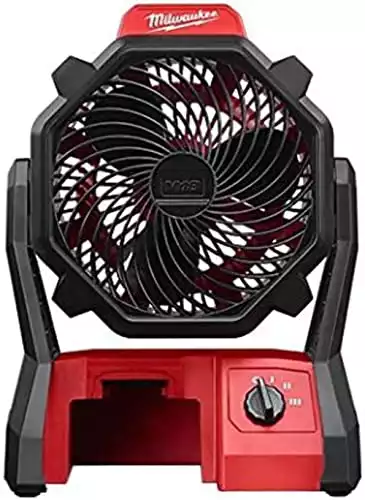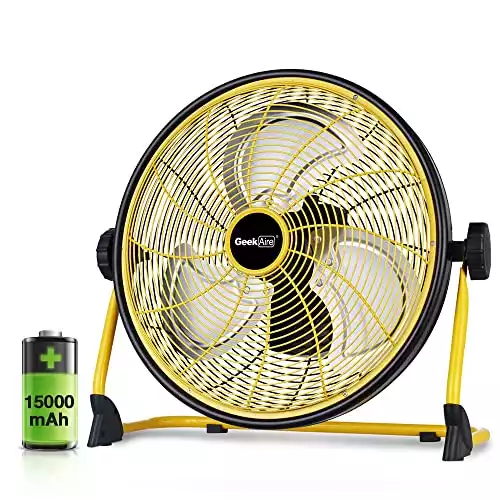Trying to fall asleep on hot, sticky nights is never fun. Camping in humid places is easier with air conditioning, but when you are out in nature and don’t an A/C or electric facilities at your campsite, you can’t just flip on a big fan to help keep you cool when the temperatures soar.
This is where having a battery-operated camping fan comes in handy. Whether you’re in a campervan or a tent, these rechargeable camping fans will keep you surprisingly cool, while still being light weight and portable enough to fit in your tent’s floor, wall or ceiling.
Even the smallest amount of airflow makes a HUGE difference when you are trying to fall asleep on an exceptionally warm and muggy night.
Without it, you will find yourself tossing and turning with discomfort for the entire evening.
But battery-powered fans are not just useful for overnight comfort. They will also promote airflow while you are lounging during the day and can reduce your reliance on your camper’s built-in air conditioning unit.
In turn, that will help you keep your rig’s internal batteries fully charged and decrease the amount of time you have to run a somewhat obnoxiously loud generator.
From small hangings fans for tent camping to larger jobsite-style models that provide airflow throughout the entire length of an RV, you have plenty of options to choose from.
Fortunately for you, we have reviewed eight of the best battery-powered camp fans on the market right now!
7 Best Battery Fans for For Van Life Or Tent Camping
In choosing these models, we tried to pick something for everyone.
That includes high-powered fans for exceptional air circulation and budget-friendly models that won’t hurt your wallet. We hope you find something that suits your fancy!
These best battery operated fans will give good circulation in a tent or van camping, even if there is not a significant breeze:
1. Tesoky-YY 10400mAh Rechargeable Camping Fan
Tesoky makes one of the most budget-friendly tent fans with a 10,400-mAh rechargeable battery.
You will be able to enjoy it for up to 36 hours on its minimum setting and up to 8 hours on its maximum setting.
It takes roughly six hours to recharge the battery completely and comes with a USB cable for recharging.
The head of the fan can be adjusted up and down to direct airflow as needed. It adjusts a full 270 degrees so that you can direct it to your liking.
If you need to leave this fan in your kid’s tent overnight, you won’t have to worry about it generating excessive heat and posing a health risk.
It is also a great choice if you are looking for a quiet unit because it produces roughly 30 decibels.
The Tesoky fan can also be flipped over and hung from the top part of your tent if you don’t have space for it on the ground.
It boasts its own hanging hook and also features an LED lantern with three brightness settings.
Things We Like
Things We Don’t Like
2. Odoland Hurricane Emergency Portable Camping Lantern Ceiling Fan
The Odoland Portable LED Camping Lantern is a 2-for-1 camping accessory.
I personally love multi-purpose items for all facets of my life and this model allows you to use it as a ceiling fan, tent lantern, or both.
It requires two D-cell batteries to power the fan and lantern.
Unfortunately, it doesn’t come with its own battery pack, but that also means you don’t have to worry about carrying or maintaining a battery charger.
If you are using it only as a fan, it will last 30 hours on the highest setting and up to 50 hours on the low setting.
A set of batteries will last up to 37 hours if using it for light only and up to 16 hours if using the light and the low fan setting simultaneously.
The Odoland model features a total of 18 super-bright LED bulbs and the head of the fan rotates up to 360 degrees for maximum control.
It will deliver up to 10 feet per second of wind speed on the maximum fan setting.
It can also be set up in a variety of ways. It includes a hanging hook, can be rotated to set it up on its own stand, or can even collapse down for handheld applications.
It is also super lightweight and compact if you don’t have a lot of room in your rig for a larger design.
Things We Like
Things We Don’t Like
3. Honeywell HTF090B Portable Turbo Personal Fan
If you aren’t ready to spend big on a new fan for your camping trips, check out the Honeywell Turbo On The Go.
This is one of the most affordable models out there and it can run on battery power or by being plugged into a USB port.
This fan is also best for close applications like keeping your laptop cool when you are getting your remote work done in your campground.
You will only be able to feel the airflow from about three feet away and closer.
Still, it can be stood up on a camp table, hung inside your tent, or carried around by hand.
The head of the fan can also be adjusted to different angles to help you direct airflow wherever you need it most.
Things We Like
Things We Don’t Like
4. MILWAUKEE 0886-20 M18 portable battery fan
So this is the fan that I picked up for my personal travels. Throughout some of the hottest parts of the U.S., it has been a game-changer for sleeping in my tent or even in the camper shell on my truck.
Full disclosure: I already had a Milwaukee battery pack from a previous tool purchase. So investing the additional cash into this portable camping fan was a no-brainer for me.
You will need to look into the price of the battery pack and the fan if you are starting from scratch.
Still, this model is super powerful and I have only really used it on its low setting in a tent or my truck bed.
It does have high and medium settings that will push air at speeds of up to 284 cubic feet per minute.
The head of the fan rotates up and down and clicks into place at nine set positions.
That allows for plenty of airflow control. I also like that I can bring this fan inside and plug it right into an AC wall outlet if needed.
Plus, it has a total of four keyhole hangers and additional hanging holes that provide nearly endless options if you are looking for a fan that can hang in several locations around your RV or travel trailer.
Things We Like
Things We Don’t Like
5. Geek Aire CFK1 Battery Operated Outdoor metal Camper Fan
The Geek Aire standing floor fan is a complete package if you are looking for one.
You won’t need to purchase an additional battery pack because this one comes with a 19,200-mAh battery built-in.
That battery provides up to 30 hours of continuous operation and only takes between 2.5 and 3.5 hours to recharge.
It also comes with a 26.5-volt power adapter for easy and fast charging.
This fan also boasts PIX4 waterproof protection and the battery is housed in a fire-resistant box.
It also boasts large diameter metal blades to promote excellent air movement and a powerful brushless motor that allows it to operate more quietly than other designs.
The maximum airflow for this fan is up to 1,250 cubic feet per minute and it even boasts a USB port that gives you the added freedom to charge your small electronic devices from its built-in battery.
Things We Like
Things We Don’t Like
6. O2COOL Treva Battery/AC Adapter Portable Fan
If you liked some of the features of the Honeywell fan but want something slightly larger, check out the Treva 10-inch fan.
It requires six D-cell batteries to run, which once again means you won’t have to worry about losing or breaking a battery charger or carrying a separate battery pack.
You will need to carry backup batteries, but this fan can also be plugged into a wall outlet using its AC adapter if you are traveling in an RV or camper.
A single set of batteries can last for up to as long as 40 hours depending on which of the fans two speeds you are primarily using.
The fan does have its own built-in stand and it can tilt to provide airflow in your desired direction.
It also folds up completely and becomes one of the slimmest and most compact camping fans out there when you need to store it.
Things We Like
Things We Don’t Like
7. Coleman CPX 1239888 Tent Fan with Stand
The Coleman CPX Tent Fan is quite possibly the best option for new campers. That is because it can be powered by a number of different power sources, which is the kind of versatility you will need if you aren’t sure what your ideal camping setup looks like just yet.
Your first option is to buy and install four D-cell batteries to power this fan. If you are interested in avoiding disposable batteries, you can also get the CPX 6 rechargeable power cartridge or use the CPX 6 AC adapter cartridge for plugging it into a wall outlet.
That flexibility is great for RVers and small campers as well. You never know when you will want to use your fan in different settings that will require power adaptability.
While the Coleman fan is primarily meant to hang from the top of your tent, it also features a built-in stand. That allows you to set it up on a camping table or even in the bed of your truck.
This fan is also safe to leave in the kid’s tent overnight because the fan blades are made of a super soft material that won’t hurt fingers if they are unexpectedly stuck in there!
In addition to its air circulating capabilities, this model also includes four 5-millimeter LED lights that produce up to 99 lumens each. It also has a white lighting mode for brighter applications and a nightlight mode for those last few moments before bed.
Things We Like
Things We Don’t Like
Buying Guide for Battery Powered Camping Fans
Choosing the right portable air circulating fan for you is largely a matter of personal preference.
But here are few factors to consider when you are comparing various models.
Fan Types
There are four main types of fans in the realm of battery-powered models for camping use.
They are desk fans, wearable (or clip-on) fans, handheld fans, and jobsite fans. Let’s look at some of the pros and cons of each:
Desk Fans
Most of the fans for this application are actually considered desk fans. They have their own built-in stands that allow you to set them up on any reasonably flat surface.
These fans are great because the heads usually tilt to direct airflow as needed and they can be moved pretty easily.
The only downsides to desk fans are that not all of these fans can be hung inside a tent and they can be a little bulkier than some of the other types.
Wearable Fans
Wearable fans come with some type of strap or clip to attach to your body or clothing.
That also makes them useful for hanging inside most tents or on a cabinet door handle in your RV.
They are generally the most portable style of fan, but they won’t be nearly as powerful as some of the other types.
They are also designed primarily for a single user instead of in a group setting.
Handheld Fans
Handheld fans are usually the smallest and lightest options out there.
That makes them good if storage is limited in your rig and you also want something you can operate with one hand. Many of them can be attached easily wherever you need them.
Once again, however, handheld fans tend to be made for a single person’s comfort. They are also relatively underpowered compared to desk fans or jobsite fans.
Jobsite Fans
Jobsite fans are going to be the most powerful of these types. They are designed to provide a high level of air circulation over a much larger area than the rest of these fans.
They are also highly durable because they are made for construction applications.
That added power and durability means that jobsite fans come in much larger packages.
They also require more energy and tend to have slightly shorter battery lives than the other types of fans.
Power Source
There are three main power sources amongst the best battery fans for camping. Those main sources are D-cell batteries, a rechargeable battery or battery pack, or an AC wall outlet.
Because you are looking for a fan for camping purposes, having one that can also plug into an AC wall outlet is simply a luxury.
The main decision you will need to make is whether you want to use D-cell batteries or get a fan with a rechargeable battery.
The fans with D-cell batteries tend to have longer run times on a single set of batteries. Some, however, require up to six batteries that will need to be replaced every time they run out.
While rechargeable batteries tend to have shorter run times, they will save you money on replacement batteries over the lifetime of the fan.
Just keep in mind that you will need a method for recharging your batteries and you will have to keep track of the battery charger (and keep it safe).
Also, some of these fans come with batteries or a battery pack and charger. Others require you to purchase them separately.
If the latter is the case, you will need to make sure you factor that extra cost into your final decision.
Fan Speed
A fan that can move air more quickly will provide more relief over a larger space.
If you only need something for a solo camper in a small tent or camper shell, you may not need a high-powered fan.
As your family grows, however, you will want a model with a higher fan speed that can produce better air circulation over a larger area.
The best-case scenario is to find a fan with at least 2-3 fan speed settings so that it can adapt according to your needs.
Dimensions
Consider where you will primarily be setting up your fan. How much space is there and how large of a fan will you be able to place there and still leave some air space around it for it to pull and circulate air effectively?
Generally, larger fans are better for RVs, travel trailers, and 5th wheels. Smaller fans tend to work better for tent camping, truck campers, and camper vans.
Weight
Fortunately, there isn’t a portable fan on our list that weighs more than 10 pounds.
But weight is still an important consideration if you are interested in ultralight camping versus traveling in a 36-foot class A RV.
Ultralight campers or folks living in camper vans tend to count ounces versus pounds because they are probably pushing the maximum carrying capacity of their rigs already.
Those traveling in larger rigs probably don’t care about the difference between three and five pounds when shopping for these fans.
Battery Life
Battery life is really important because your fan won’t be any good if you run out of battery.
Generally speaking, more battery life is always better, but be careful to couple this consideration with our thoughts from the ‘Power Source’ section above.
While a fan with a 40-hour battery life sounds better than one with a 20-hour life up front, you will end up spending a lot more if you need to buy a whole new set of batteries after 40 hours versus just plugging your battery pack into a charger after 20.
Noise Output
You should also consider how much noise each of these fans produces. Do you want something that circulates air as quietly as possible? Or do you actually enjoy the white noise that the louder fans create?
Ultimately, it is a matter of your preference, but check out the decibel levels produced by each fan before finalizing your choice.
You can also use this handy decibel comparison chart to give you a more concrete idea of what that otherwise arbitrary decibel number really sounds like.
Frequently Asked Questions
Most of these fans are relatively easy to use and simple to maintain. However, there are a few additional questions that we think are very important to address while you are still hanging around with us!
Do all camping fans come with batteries?
No. Unfortunately, you will need to double-check whether or not the fan you are interested in comes with batteries.
In some cases, the battery pack required for the fan can even be more expensive than the fan itself.
This is typical of the more high-powered jobsite fans out there, so be aware of this while you are making your selection.
How long do portable camping fan batteries last?
It really depends on the style. Many rechargeable battery fans will last anywhere from three to 12 hours on a single charge.
With this style, it will also depend on the setting you are using. Higher settings (i.e. faster fan speed) will drain the battery more quickly.
For non-rechargeable fans that run on replaceable batteries, it is not uncommon for the fan to run for up to 40 hours before you need to change out the batteries.
How often do I need to clean a fan for camping?
You will need to give your fan a little TLC in the form of blade dusting and cleaning every 2-3 months.
This is a standard timeframe, but your fan may need to be cleaned more or less frequently depending on how often you are using it and how dusty the air typically is when you are camping.
How much do battery fans for camping cost?
You can certainly get a cheap model for less than $20 online these days.
If you are looking for something that is still reasonably affordable but slightly higher in quality, you will probably spend between $50 and $100.
There are still high-end jobsite fans that will cost more than $100 and you will have to keep in mind that the battery packs for some of these fans will cost as much (if not more than) the fan itself.
How much noise do portable fans produce?
Some of these models are actually pretty quiet, but the noisiest will produce upwards of 60 to 80 decibels (roughly the equivalent of a vacuum cleaner or dishwasher).
If you are looking for the quietest model possible, you will need to target something in the 40-50 decibel range.
Conclusion
From my personal experience, I highly recommend ditching your ego and dropping a little dough to make your camp life more comfortable.
Yes, humans are arguably the most adaptable species on the planet, and, yes, you very well may be comfortable falling asleep when it is 90 degrees with 100% humidity.
For all the rest of you, these fans are an excellent way to promote additional airflow in your tent, camper van, truck camper, or even larger RV or travel trailer.
And they are a lot cheaper than installing a whole new ceiling vent fan in your rig.
As always, we hope that you have enjoyed this guide and increased your RVing Know How in the process.
We want to take this final moment to wish you nothing but the happiest and healthiest of adventure travels in the months to come!













